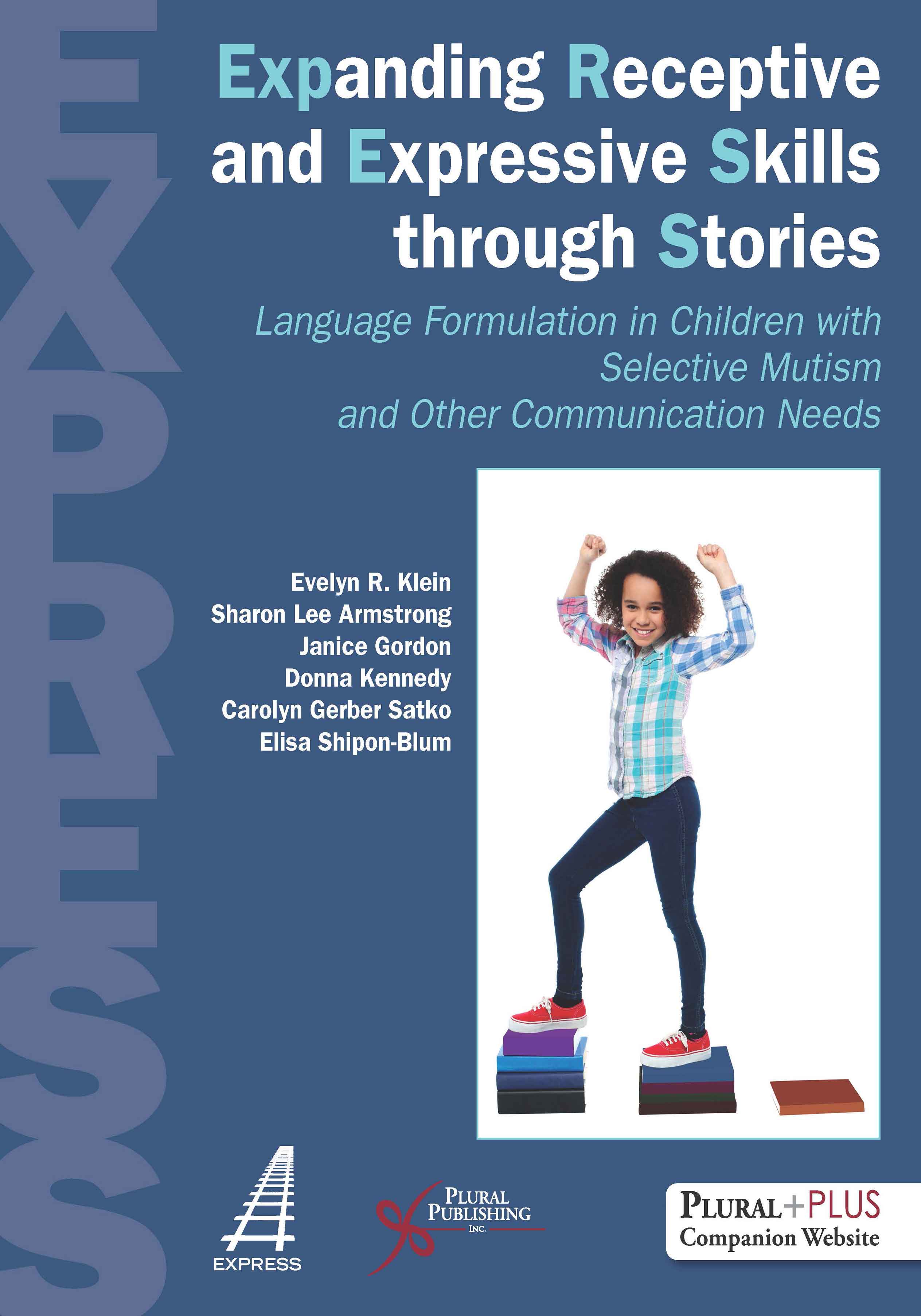
Treating Selective Mutism as a Speech-Language Pathologist
First Edition
Emily R. Doll
Details: 202 pages, B&W, Softcover, 6" x 9"
ISBN13: 978-1-63550-281-7
© 2022 | Available
Purchase
Selective mutism (SM) is an anxiety disorder in which individuals are unable to communicate in certain environments or contexts (such as at school or in the community) despite having appropriate speech and language skills in other settings. By drawing on their extensive knowledge of language development, language complexity, and therapeutic approaches, speech-language pathologists (SLPs) can provide life-changing results for children with SM. Treating Selective Mutism as a Speech-Language Pathologist is a comprehensive yet accessible resource designed to bridge the gap in the current SM literature and empower SLPs to treat this disorder effectively. This valuable professional resource has tools for SLPs at every stage of their careers, from new clinicians preparing for potential cases of SM to experienced SLPs looking to expand their knowledge base.
The first three chapters of Treating Selective Mutism as a Speech-Language Pathologist offer a base of understanding by exploring the roots and characteristics of SM. The text then walks clinicians through effective assessment and diagnosis strategies. The final chapters provide evidence-based treatment strategies, as well as practical guides and activities, for supporting children with SM.
Key Features
- Ready-to-use activities, handouts, and forms that can be reproduced and implemented during a therapy session
- Up-to-date empirical evidence regarding the etiological factors of SM
- Overview of the collaborative team approach necessary for treating SM
- Suggestions regarding specific assessment materials and a specific protocol to guide data collection during assessment
- Specific, evidence-based treatment strategies provided in a clear, easy-to-understand manner
- A PluralPlus companion website with printable versions of the resources in the book
Emily R. Doll Discusses Treating Selective Mutism as a Speech-Language Pathologist
Reviews
“This practical resource provides speech-language pathologists with up-to-date and accurate information for treating selective mutism in children. The accompanying website provides all the forms found in the appendix of the book in digital format.
…The material presented in the accompanying website allows the SLP to print the resources provided in the book's appendix…
The book is written for SLPs who work with children suspected of having selective mutism; however, it would be very informative to parents or other practitioners working with these same children. The author has a background in developmental psychology as well as speech pathology. She has presented at both the state and national levels on selective mutism and has provided treatment to children ranging from preschool to adolescence.
The book is broken up into six easy-to-read chapters. The first three chapters provide background information to understand what selective mutism is and what it is not. The last three chapters explain how to assess and treat a child with selective mutism effectively and accurately. As a useful resource, the book also provides about 50 pages of various resources from case history forms, letters to friends, activities that can be used in therapy, and many other resources.
The book is very easy to read and yet provides comprehensive and practical information regarding selective mutism. With its ready-to-use activities and handouts, up-to-date empirical evidence, and suggestions on assessment material and therapy activities, this book is a useful resource for SLPs.”
–Yvana Uranga-Hernandez, PhD, CCC-SLP, Biola University, from Doody's Reviews (May 2022)
“Doll’s Treating Selective Mutism as a Speech-Language Pathologist provides a concise and clear description of how selective mutism presents in children, the history of the condition and suggestions for assessment and intervention for clinicians.
The first two chapters offer a straightforward description of how the body responds to anxiety and a brisk, informative overview of the history of selective mutism and the aetiological factors that appear to contribute to the condition. Together these sections outline the welcome move away from the position that this is a condition that is wilfully adopted by children and young people as shown by the change in terminology from its earliest descriptor as aphasia voluntia through elective mutism to the current selective mutism. This point is reinforced throughout the book: selective mutism is a multifactorial condition with genetic and environmental causes…
One of the appealing aspects of Doll’s book is its accessibility, and this comes across in the diagrams used to describe what happens to the anxiety levels if a child is always rescued or avoids a situation contrasted with when they are supported to ‘ride out’ an anxiety response. The descriptions and visuals can easily be reproduced in a clinical setting with a pen and paper to help explain what is happening and how taking small brave steps will help to reduce the anxiety over time.
… The second half of the book is devoted to treatment techniques, shared goal setting and ideas for therapy activities and this is well supported by a section on resources. The level of detail on child directed interaction with example dialogues and activities to practice is especially useful. The description of different treatments and session activities are clearly explained and the resources are refreshing in their low-key format. They are easy for clinicians to reproduce and adapt to their clients – the bravery reward charts and different homework tasks for children to take away and work on between sessions are particularly welcome. There is also a brief section signposting books for reading with children, their peers and families as well as other references for clinicians to explore further information and resources.
Doll’s book provides a concise and clearly written overview of selective mutism with some intervention ideas, strategies and resources which adds to the toolbox of clinicians working with this client group and as such it provides a welcome addition for speech and language therapists supporting children and young people with selective mutism to participate in academic and social activities and ultimately to use their voice in more contexts.”
–Nancy Campbell, BA, from Child Language Teaching and Therapy (May 2022)
Preface
Acknowledgements
Reviewers
Introduction
Chapter 1. Overview of Anxiety
Chapter 2. History of Selective Mutism and Etiological Factors
Chapter 3. Characteristics of Selective Mutism
Chapter 4. Assessment and Diagnosis of Selective Mutism
Chapter 5. Treatment Techniques for Selective Mutism
Chapter 6. Meaningful Goals and Therapy Activities
Resources
Case History
Sample Letter to New Classmates/Friends
Selective Mutism at School Handout (Teacher Tip Sheet)
Sample Talking Map
Classmates and Friends Rating Form
Teachers and Adults Rating Form
Playdate Log
Sample Ritual Sound Approach Chart
Brave Talking Practice Assignment Sheet
Feelings Rating Chart
Brave Talking Questions
Brave Talking Goals
Brave Talking Ladder (5 Steps)
Brave Talking Ladder (10 Steps)
Find-A-Friend Bingo
Brave Talking Chart (10 Spaces)
Brave Talking Chart (80 Spaces With Row Markers)
Brave Talking Chart (80 Spaces)
Brave Talking Weekly Chart (for Classroom)
Pets Survey
Birthday Survey
Seasons Survey
Siblings Survey
Ice Cream Survey
Challenge Cards for School
Nature Walk Scavenger Hunt
Bookstore/Library Scavenger Hunt
Grocery Store Scavenger Hunt
Department Store Scavenger Hunt
Additional Resources
References
Index
Purchase of Treating Selective Mutism as a Speech-Language Pathologist comes with access to supplementary materials on a PluralPlus companion website.
To access the materials, you must register the access code printed on the inside front cover of your book on the companion website.
*Note: If you have purchased this book used or have rented it, your access code will not work if it was already redeemed by the original buyer of the book. Plural Publishing does not offer replacement access codes for used or rented books.

Expanding Receptive and Expressive Skills through Stories (EXPRESS): Language Formulation in Children with Selective Mutism and Other Communication Needs
First Edition
Evelyn R. Klein, Sharon Lee Armstrong, Janice Gordon, Donna Spillman Kennedy, Carolyn Gerber Satko, Elisa Shipon-Blum
Details: 554 pages, B&W, Softcover, 8.5" x 11"
ISBN13: 978-1-63550-050-9
© 2018 | Available

Here's How to Do Early Intervention for Speech and Language: Empowering Parents
First Edition
Karyn Lewis Searcy
Details: 288 pages, B&W, Softcover + CD, DVD, 8.5" x 11"
ISBN13: 978-1-59756-440-3
© 2012 | Available

Assessment of Communication Disorders in Children: Resources and Protocols
Fourth Edition
M.N. Hegde, Frances Pomaville
Details: 444 pages, B&W, Softcover, 8.5" x 11"
ISBN13: 978-1-63550-266-4
© 2022 | Available

ECHO: A Vocal Language Program for Easing Anxiety in Conversation
First Edition
Cesar E. Ruiz, Evelyn R. Klein, Louis R. Chesney
Details: 225 pages, B&W, Softcover, 8.5" x 11"
ISBN13: 978-1-63550-330-2
© 2022 | Available

